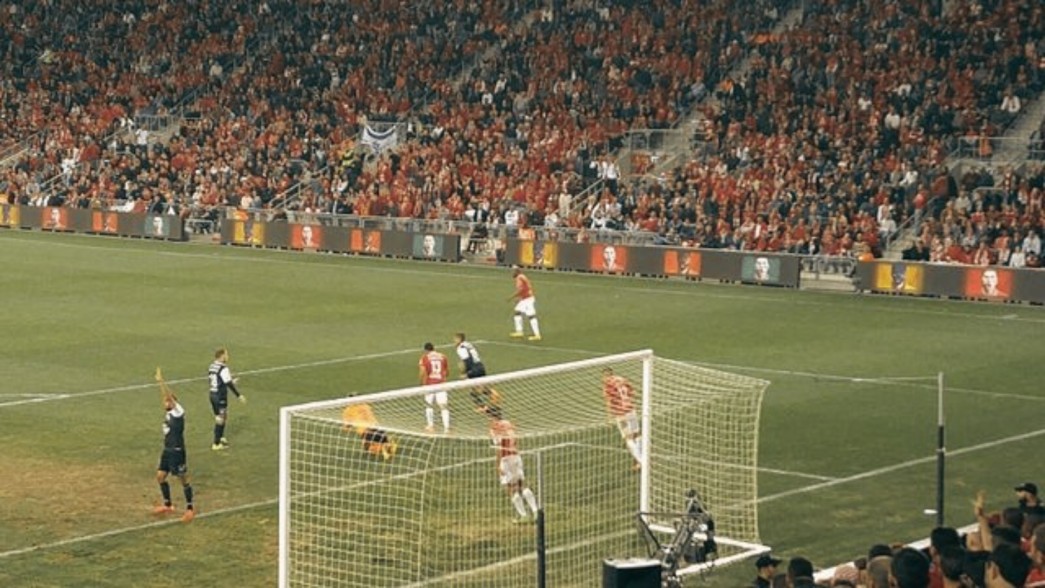While we’ve been watching the Euros, football in northern Kerala raises big questions around theology, modesty, and representation for its Muslim fans and players. In this article, Shahdab Perumal shares some of his fieldwork on the relationship between football and the concept of awrah (nakedness).

The intense love for football in northern Kerala, India is widely acknowledged. There is an intriguing relationship between football and faith among the Muslim community in Malappuram, where there is a tension around awrah (nakedness). But the lens of pleasure and leisure is insufficient to comprehend the football games — I attempt to narrate playing football through the lens of faith among Muslims in Malappuram, Kerala.
The central focus of my research is the everyday football games happening in the mornings and evenings. The playground is generally a small portion of land, field, or beaches. This kind of football game is known as Kandam Kali.
Here, the lens of faith immediately complicates playing football by wearing a t-shirt and shorts, as shorts do not cover awrah properly. To look at this more closely, I have been conducting ongoing ethnography in the Malappuram district.
Wearing football shirts is ubiquitous now around the world, including among Muslims. The joke is that “today, Neymar, Messi, and Mbappe performed their Namaz together in the Masjid.” The joke underscores or acknowledges that wearing the shirt in everyday life is very ordinary. But when it comes to shorts, unlike the football shirt, the shorts must be concealed under their clothes. Wearing shorts is not common.
One day, Afeef, a graduate student, came a little late to the ground, wearing new trousers and a shirt and not his usual t-shirt and shorts. “I just came to see the game; I am not playing today. I am coming directly from my mother’s home, and if I play in this dress, my mother will surely scold me.” Afeef said. Sabik responded, “A boy in Malappuram always wears [shorts] under his trousers or loincloths; he is always ready to play football. He would never cite not wearing [shorts] as a reason for not playing.”
Another day, a boy’s mother had joined them to watch a game. After a moment, she shouted to her son, “Give me the remote, see, they have not even covered their awrah, stop it” to which her son responded, “there are Muslim players also in the team, and they are pious. I will change the channel once the half time comes” and we continued watching the game. By raising the question of awrah, she hinted that they are engaged in a morally corrupt act. The response is crucial to understanding the tension between awrah and football, because the negotiation also revolves around the presence of Muslims, making it a point to justify continuing to watch the game. The duality that is very much present in the conversation between this mother and her son is that, on the one hand, football is considered a game of transgression of faith, a game of not covering nakedness; but on the other hand, defending representation of Muslims in football.
Meanwhile, a graduate student, Nabeel, shared that “the concern of awrah is real; there are attempts that some of the players, who are more pious, wear lengthy socks or they often wear tracksuits and play so that the problem of awrah is addressed.” Similarly, Muneer, a student at the religious learning [center], said “they are not allowed to play football wearing [shorts] at the campus, and they wear tracksuits.”
But is it possible to theologically justify wearing shorts while playing football?
Hashir, a student at a religious institute, shared that while playing football one evening, as they were playing wearing shorts, one of the ustad (a scholar) saw them and interrupted and told them wearing shorts and playing football transgressed the faith as they were not covering their nakedness properly. Interestingly, one of the players disagreed, provided theological justification, and argued that revealing the thigh does not transgress the faith – providing a curious invocation of tradition that there was an instance in which the Prophet’s (peace be upon him) thighs were visible. Hence, he argued that playing football while wearing shorts does not “break faith”. However, this curious case of citing the Prophet in this way is seemingly uncommon.
During my research, Shabna, the sister of one of the football players, noted the absence of any discourse or discussion about why is it so normalised that even very pious people play football wearing shorts. Muneer, a graduate from a religious institute, explained that students at the institute cite and refer to different Hadith and other stories to make a point that playing football is part of the faith. The prominent Hadith, says Muneer, is that “Allah loves healthy worshippers.”
There are further discussions around gender and masculinity when it comes to wearing shorts and playing football. Shyness and modesty are usually perceived as traits in girls and women, yet here faith interrupts this stereotype, pressure to be modest is extended to boys and men. Football and modesty then are seen as masculine in this context.
It is also fascinating to note that the Malayalam saying trouser itu nadakuna kalam (the age one wears trousers) indicates childhood. The saying is used to mock a youth, suggesting he has not grown up. The saying underscores that shorts are suitable for children and one wears trousers as one grows up. Caroline and Filippo Osella (2007) lucidly argue that Muslim men, especially in Malabar, are at ease with modern and open to mainstream fashion and style. In addition, the authors demonstrate that the adaptation of modern dress contradicts and nullifies the stereotypical representation of Muslims, especially in television serials, in which they appear uncouth and rural. Intriguingly, the authors acknowledge that even though Muslim youth follow a pan-Kerala style, interestingly, the dress of Muslims is defined by subtle distinctions. The authors provide the instance that Muslim men’s choice of standard shirts and pants is relatively sober in colour, design, and fit. Bringing the tension of awrah and wearing shorts to the discussion regarding Muslim men’s dress shall further complicate the neat conclusion. In addition, it shows and makes a blatant case of the role of faith in Men’s dress style.
The discussion on awrah is mainly restricted to females, and I hope this research will kindle a fresh debate about the question of awrah for males.
I want to conclude with an anecdote. I recently presented an earlier version of this paper at a conference on gender and religion. Interestingly, one of the audience members showed an unusual curiosity about my paper, and later, during the tea break, he came to me and said, “I am also from Malappuram; your paper is very accurate” and showed me his shorts under his trousers, and reaffirmed to me that boys in Malappuram always wear shorts under their trousers.
Photo by Adityan Ashokan





